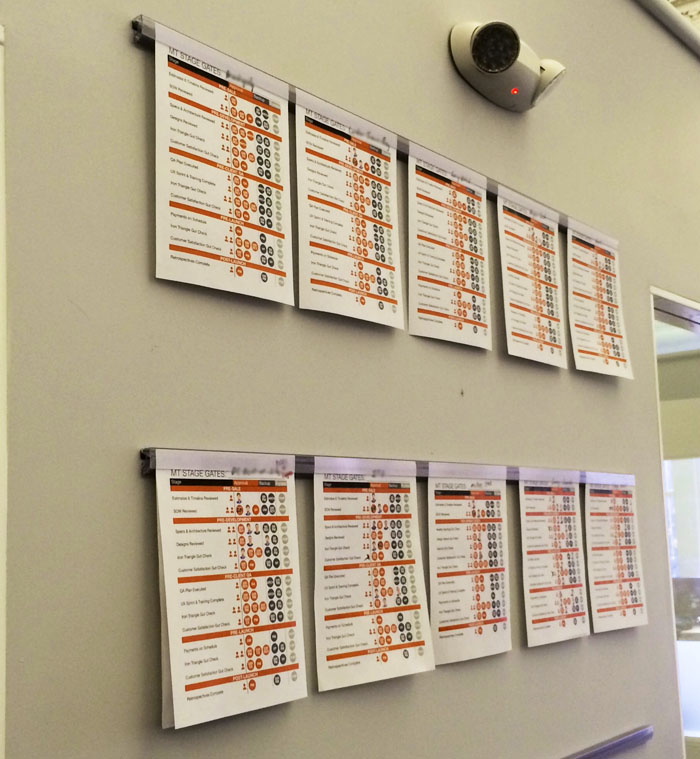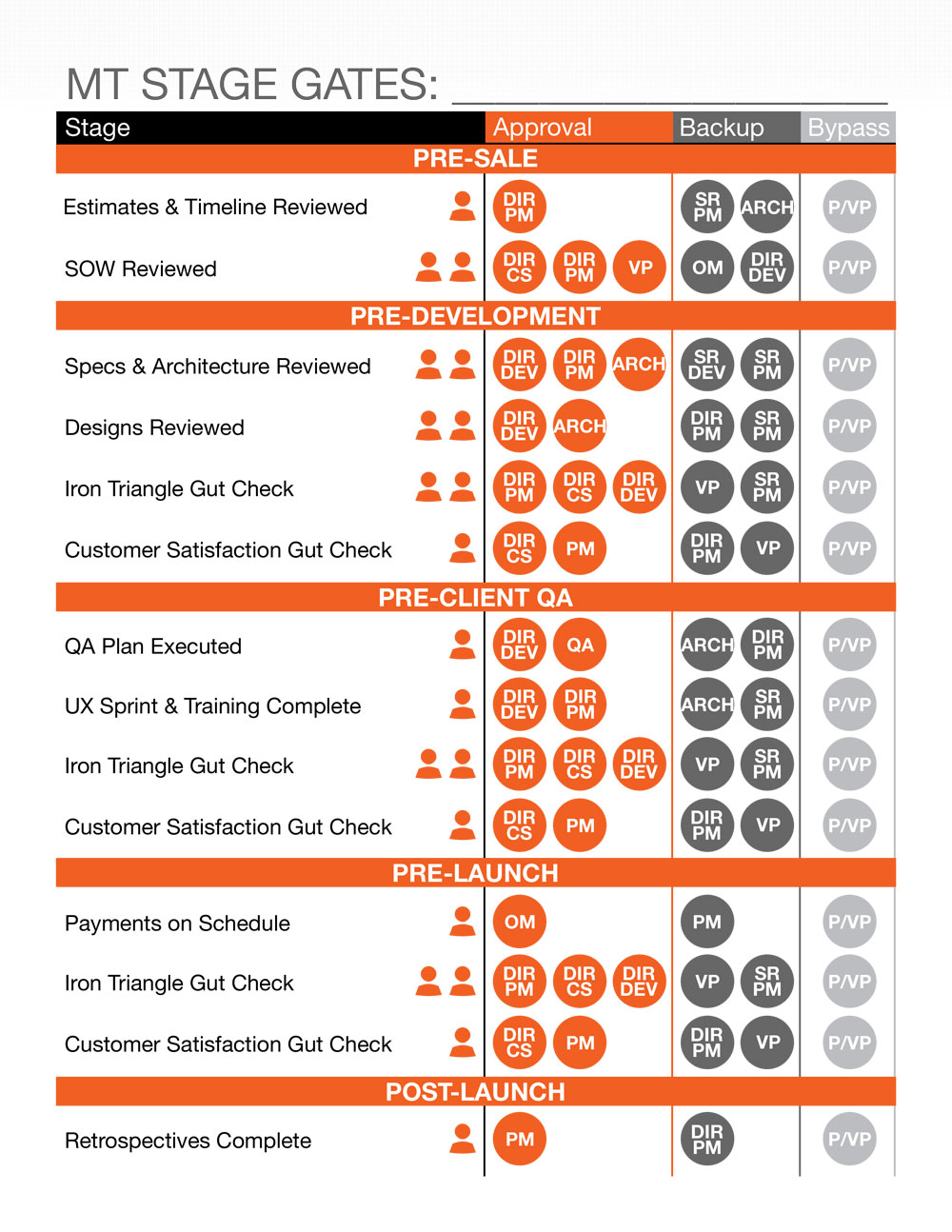One of the newer processes we’ve implemented at Metal Toad is that of stage gating. I was going to title this post "Stage Gating for Project Success," but really it’s all about risk avoidance and limiting potential failure on projects by following our tried and true steps to keep projects on track.
What is stage gating, you ask? Simply put, stage gates are approval checkpoints during the life cycle of a project. Depending on the level of complexity involved with a specific stage and the risk of failure of that stage is skipped or completed insufficiently, different levels of experience and seniority within the company are required to approve a stage.
"That sounds like lots of red tape," you say. Yes, potentially, but we’ve worked to implement stage gates in a way that create mental triggers for project “stage” completion rather than outlining a dogmatic list of how things need to be done. The stages also make sure that our senior staff and executive team are never too far removed from projects, forcing them to give gut checks, provide insights, and question assumptions made by project teams.
The Format
Confused? Let’s give some visual representation. Since we’re an agency full of engineers, there are plenty of people who wanted to create an app, but for the MVP version of stage gates, we went with plain old paper printouts hung on a wall.

The physical format gives certain weight to their importance, and it makes them hard to ignore or forget. We even gamify things a bit with headshot stickers of staff members placed on circles when a stage is approved.

So many of mini me!
Here’s a single stage for statement of work review:

Interpretation is pretty simple. The two headshot icons indicate that two people need to review statements of work before they go out the door. The “Approval” column is the primary approvers who should lay eyes on the SOW (in this case, director of client services, director of project management, and vice president). “Backup” (office manager and director of development) are the roles that can review if primary approvers aren’t available. The “bypass” column are roles (president or vice president here) that can approve skipping a stage entirely, which for a SOW would either mean closing work without a SOW or sending a SOW unreviewed.
With that, here’s one of the variations of our stage gate document:

We have numerous options when it comes to stage gates, ranging from more traditional plan > build > ship projects to sprint-based agile projects. The project phases are becoming increasingly decoupled in printed form so that multi-phase projects, discovery projects, and design projects can all be accounted for with stages.
Metal Toad’s Stages
With that out of the way, let’s delve a bit into our most important stages and why they exist. Yours may differ a bit, but I suspect that many of the core tasks we need to complete on a project will ring true for you too.
Sales Stages
A project can be doomed from the start if the sales process is handled poorly. Here’s what we make sure to always do before closing a project to avoid catastrophe:
- Review the proposal - For bigger project prospects, we’ll create a proposal deck. It’s important to get enough eyes on the content and the formatting before things are sent to the potential client. A typo in the wrong spot can lose a lot of potential money.
- Review the timeline and resourcing - Our PM team always has a say in what we commit to from a resource and timeline perspective on the sales front. We know the projected resource calendar better than anyone else in the organization, and we make sure timelines are realistic so that we can actually follow through on what we sell.
- Review estimates - I’m not inclined to disagree with those who postulate that software estimation is difficult and a poorly educated guess at best, but general budget guidelines have allowed us to sell projects with budgets that can be realistically steered towards by a project manager. For instance, an estimate of $80K for a social networking site is a guaranteed loss before we even start the project.
- Review the statement of work - We make sure our SOWs are sufficiently scrubbed to confirm that details such as feature set, timeline, costs, warranties, and terms are all present and well defined. Holes in a statement of work put a project manager at a significant disadvantage when it comes to scope control.
Planning & Design Stages
Whether you’re talking about a traditional waterfall planning process or agile sprint zero, planning is one area most susceptible to skipped stages and rushed timelines. When those stages are skipped, it can result in massive misses on timeline, budget, and client satisfaction. Make sure you:
- Create specifications - ”Specifications” is a very loose term, as that could mean a traditional technical specification document, a well-defined backlog of tasks and acceptance criteria as tickets or cards, or any other number of formats. Different projects call for different solutions, but the recurring theme is that when we don’t document plans well enough, we sacrifice scope control and blow budgets because we haven’t told clients what they’re getting or set expectations well.
- Complete architecture reviews - We have a range of development skill levels on our team, but every Metal Toad project architecture plan is developed or reviewed by our front and back-end architects before we break ground on development. This ensures that we build sustainable, scalable products that follow proper design patterns and avoid poor code.
- Complete design reviews - When our technical team isn’t sufficiently involved in UX and design review, we can wind up with designs that are mismatched with the technologies in use, sites that are a nightmare from an administration standpoint, or any other number of scenarios that make us sad. By working closely with our design teams, we balance creative thinking with the realities of technical implementation.
Development & QA Stages
Good development practices and established QA and testing will usually avoid producing a lemon. That mean’s you really shouldn’t skip these steps:
- Review the backlog health - Does your backlog exist? Is it sized and prioritized? It’s important to make sure there’s a clear and up-to-date plan for what to build and in what order to build it. Without that, you risk idle developers or misplaced development priorities.
- Provide development velocity gut checks - Are you going to finish on time? That’s an important question to regularly ask yourself and your team for obvious reasons. Keep your burn-down charts or project plan and timeline tracking updated.
- Complete our administration UX sprint - Metal Toad has a goal of making sure our projects go out the door with a bit of extra TLC given to administrative experience. The value of a great site visitor experience can be completely invalidated by site administration that makes your clients shy away from using it.
- Execute the QA plan - Whether we’re using BDD and automated testing, unit testing, human testing, or any other combination of approaches, having a robust QA plan and sticking to it will make sure that we don’t hand off an embarrassment to the client.
- Provide client training - What good are those administrative enhancements if your clients don’t know how to use them. Make sure training happens in a way that’s sustainable for the ever-changing needs and stakeholders on the client-side.
Deployment/Wrap-Up Stages
By the time you’ve reached deployment, the risks of wrecking a project have lessened a bit, but there are still some stages it’s advisable to respect if you want to have a healthy agency and long-term relationship with a happy client:
- Confirm on-time payment - Not to be sticklers, but it’s nice to make sure that invoices have generally been paid on time and the client doesn’t have the entire project balance outstanding before you ship their project out the door. Just good business sense and all…
- Complete deployment checklists - Deployments can be finicky, and any interaction with production servers comes with an increased level of risk. We make sure to follow our standardized deployment process and always pair for deployments to get two sets of eyes on the steps involved.
- Hold retrospectives - Was your project a rousing success? Pop some champagne! But even in that case, don’t skip retrospectives. Projects are never perfect, and sharing knowledge and major takeaways with your team will help you repeat success and avoid land mines in future projects. Hold a client retrospective once the dust has settled too. Owning up to your mistakes and planning for how to do it better next time will only earn your team additional respect.
Recurring Stages
Some things are important enough that you’ll want to keep a constant pulse check going throughout the duration of a project:
- Provide PM iron triangle gut checks - When it comes to agency work, we believe that every project needs to be approached from a PM iron triangle (scope/budget/timeline) perspective when it comes to risk management. Even a “pure agile” project with buy-in from primary client stakeholders has budget that runs out at some point, a higher-up somewhere on the client side that will demand a deadline, and a board or c-suite with aspirational expectations that may not fall in line with MVP. Performing regular gut checks on the components of the iron triangle will help identify risks early and often.
- Provide customer satisfaction gut checks - You may be completing every other stage on this list to perfection, but if your client isn’t happy, does it matter? The great part here is that if you don’t know how your client feels about the project, you can ask them, and they’ll usually tell you exactly how to make them happy if they’re not already. Even if their unhappiness doesn’t stem from your team or is out of your control, just letting them vent about why they’re unhappy will go a long way.
There are many additional stages and decisions that should be considered during the course of a project, but these are the ones that we count as absolutely crucial. Any one of them could mean significant project failure when it comes to customer satisfaction, agency profitability, or both. We’ll continue to evolve this process over time, but so far so good. If you have other thoughts on important stages with serious negative implications when skipped, we’d love to hear them!



